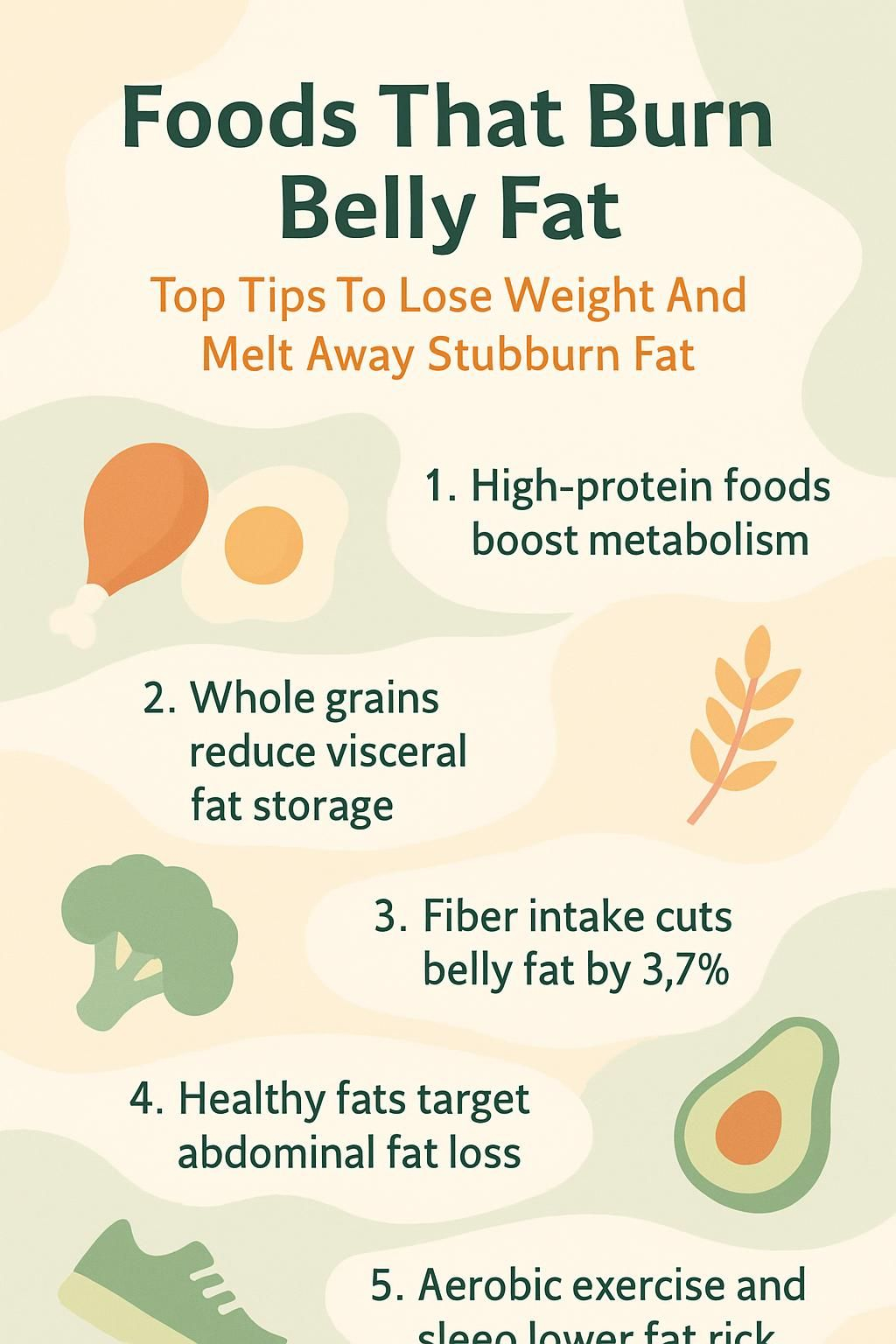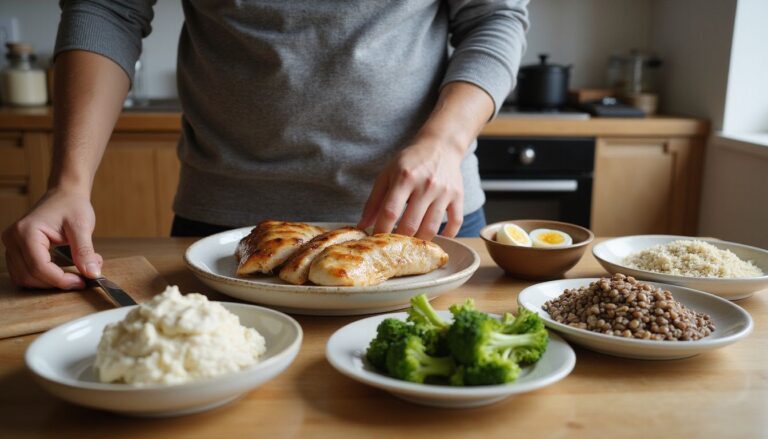Foods That Burn Belly Fat: Top Tips To Lose Weight And Melt Away Stubborn Fat
Our Nutrition Assistant AI Suite will transform your body. You will lose fat, get toned, and build muscle. Gain confidence and optimal health.
Trying to lose belly fat can feel frustrating. You cut calories, you move more, yet your waist barely changes. The right foods can help you target abdominal fat, the fat in your midsection, and support better health.
This guide explains simple choices that help you lose weight with less stress. You will learn how protein, fiber, healthy fats, and green tea work together. You will also get clear tips to shape a steady eating plan that fits your life.
Key Takeaways
- High protein foods, like eggs, lean meats, Greek yogurt, and fish, increase fullness and support a higher metabolism, which helps reduce belly fat.
- Swap refined carbs for whole grains such as brown rice, quinoa, and oats. This steadies blood sugar and lowers insulin spikes that drive visceral fat storage.
- Fiber-rich produce, including apples, pears, broccoli, and spinach, boosts fullness. A daily 10 gram increase in fiber linked to a 3.7 percent drop in belly fat over five years.
- Healthy fats from avocados, nuts, seeds, oily fish, and olive oil support abdominal fat loss when they replace saturated and trans fats.
- Consistent habits matter. Aerobic exercise, strength training, water instead of sugary drinks, portion control, at least 7 hours of sleep, and stress management reduce visceral fat risk.
[1] Harvard T.H. Chan School of Public Health: The Nutrition Source – Sugary Drinks

What Are the Different Types of Belly Fat?

Belly fat is not all the same. Each type behaves differently in your body and can affect your health in different ways. Knowing the difference helps you choose better strategies for fat loss and for long-term health.
What is subcutaneous fat?
Subcutaneous fat sits just under your skin. You can pinch it around your stomach, hips, arms, or thighs. Many people notice it as the soft layer that covers the muscles of the abdomen.
It is less risky than visceral fat, which sits deeper around your organs. Still, too much subcutaneous fat raises total body fat and can affect blood sugar and long-term health. Reviews link higher levels to a greater risk of type 2 diabetes over time, especially without a healthy diet and regular aerobic exercise or strength training.
You can reduce extra subcutaneous fat by using more calories than you eat each day.
What is visceral fat?
Visceral fat is the deep belly fat that surrounds organs like the liver, stomach, and intestines. You cannot pinch it. Doctors see it as the most dangerous type because it releases substances that disrupt hormones and blood sugar control.
High visceral fat links to insulin resistance, heart disease, sleep apnea, and type 2 diabetes. People with larger waistlines usually have more of it. Lowering visceral fat improves how your body uses oxygen and nutrients and can support a healthier circulatory system.
What is intramuscular fat?
Intramuscular fat is fat stored within skeletal muscle. It gets less attention, but it can increase when you eat many high-calorie foods and move less. Higher levels may relate to insulin resistance and slower metabolism.
Low muscle mass and little activity can make intramuscular fat rise faster. Building stronger muscles and keeping a steady exercise routine help limit this type of fat while you work on your waistline.
Why is it important to reduce belly fat for your health?
Excess belly fat, especially visceral fat around your organs, raises your risk for type 2 diabetes, fatty liver disease, and heart disease. Sugary foods and drinks add many calories and push blood sugar higher, which promotes fat storage.
Losing visceral fat can improve how your body uses oxygen and nutrients.
Short sleep and long-term stress make fat loss harder. Sleeping fewer than five hours a night was linked with more weight gain in a large 16-year study of more than 68,000 women. Ongoing stress raises cortisol, a stress hormone, which can drive belly fat storage. Small changes in diet and daily movement add up and support better long-term health.
Foods That Help Burn Belly Fat
Some foods make it easier to control hunger, steady blood sugar, and burn more calories. Building meals around these choices can help you lose belly fat more effectively.
Which high-protein foods burn belly fat?
Protein helps you stay full, protects muscle during weight loss, and slightly increases the calories you burn during digestion. Try these smart picks:
- Eggs offer about 75 calories and 7 grams of protein each, which helps you feel full after breakfast.
- Lean meats such as skinless chicken breast, top sirloin, and turkey give you protein with fewer calories.
- Fish like salmon and mackerel supply protein and omega-3 fatty acids, which link to less visceral fat.
- Greek yogurt packs nearly twice the protein of regular yogurt. Choose low sugar, nonfat or low-fat options.
- Beans and lentils deliver protein plus fiber, which supports steady digestion and fewer cravings.
- Nuts such as almonds add plant protein and healthy fats. A small serving helps with fullness.
- Whey protein can raise daily protein intake without much saturated fat.
Longer lasting fullness and better body composition are the two main benefits for fat loss.
Are lean meats like chicken, fish, and turkey good for belly fat loss?
Yes. Lean meats support muscle and reduce hunger. A serving size of 3 to 4 ounces is ideal to control calories. Fish also provides omega-3s, which support heart health and may reduce visceral fat when you eat it a few times each week.
Pair lean meats with vegetables and a whole grain like quinoa or brown rice. This mix balances protein, fiber, and slow-digesting carbs for steady energy.
Can eating eggs help reduce belly fat?
Eggs are a simple way to get high-quality protein and feel satisfied. A protein-rich breakfast helps you eat fewer calories later in the day. Research suggests higher protein mornings can help reduce body fat, including in older women.
Try eggs with vegetables or a side of fruit. Many people find they snack less after an egg-based breakfast.
How do beans and lentils support belly fat burning?
Beans and lentils are rich in protein and soluble fiber, the fiber that forms a gel in your gut and slows digestion. One cup of chickpeas contains about 12.5 grams of fiber and 15 grams of protein with little fat. That combination helps you stay full and keep calories in check.
Regular intake supports better blood sugar control and may reduce visceral fat risk. Add black beans to tacos or toss lentils into soups for a budget-friendly boost.
Why is Greek yogurt beneficial for losing belly fat?
Greek yogurt offers more protein than regular yogurt, so it takes longer to digest and helps with appetite control. Choosing nonfat or low-fat, low-sugar versions cuts calories while keeping a creamy texture.
Options with probiotics, the helpful bacteria in your gut, can support digestion and weight regulation. A simple snack of plain Greek yogurt with berries adds natural sweetness without added sugar. I swapped my usual chips for Greek yogurt with walnuts and cinnamon and noticed a smaller waist after six weeks, along with daily walks.
What fiber-rich fruits help burn belly fat?
Fruits with soluble fiber and water improve fullness with fewer calories. Choose these often:
- Apples, with skin, provide water and soluble fiber. A 10 gram daily increase in soluble fiber linked to a 3.7 percent drop in belly fat over five years.
- Pears slow digestion and tame hunger. Whole fruit beats juice for fiber.
- Berries, including blueberries and raspberries, are low in calories and rich in antioxidants and fiber.
- Grapefruit offers water and fiber. Some studies suggest benefits for weight control.
- Oranges give vitamin C and soluble fiber. Eat the fruit, not the juice, to keep the fiber.
- Avocado supplies fiber and healthy fats that improve fullness.
- Kiwi adds vitamin C, potassium, and fiber, plus antioxidants that protect cells.
Adding these fruits supports fullness and better blood sugar control, which helps you stick to your plan.
Which vegetables are best for reducing belly fat?
Vegetables are low in calories and high in fiber and water, so they help you fill up without overeating. These are smart staples:
- Broccoli, rich in soluble fiber, supports gut health and fullness.
- Spinach supplies fiber with very few calories, which helps control appetite.
- Carrots provide fiber and beta-carotene and can curb snack cravings.
- Celery is ultra low calorie, which makes it a satisfying crunchy snack.
- Sweet potatoes bring fiber, potassium, and beta-carotene for steady energy.
- Leafy greens like kale offer antioxidants and volume for minimal calories.
- Bell peppers add fiber and vitamin C, and they work well in many dishes.
Mix raw and cooked vegetables for taste and variety. A simple olive oil and lemon dressing keeps calories in check.
How do whole grains like brown rice, quinoa, and oats help burn belly fat?
Whole grains digest slowly and steady your blood sugar. This reduces insulin spikes that trigger fat storage around the organs. Quinoa gives about 8 grams of protein and 5 grams of fiber per cooked cup. Oatmeal is high in fiber and water, which boosts satiety.
Bulgur, used in tabouli, is high in fiber and low in calories. Switching from white bread to oatmeal or brown rice can cut bloating and reduce overall calorie intake without losing flavor.
What healthy fats help target belly fat?
Replacing saturated and trans fats with healthy fats supports fat loss and heart health. Good choices include:
- Avocados with monounsaturated fats that link to lower visceral fat.
- Nuts, such as almonds and walnuts, which support a healthy body mass index when eaten in small amounts.
- Chia seeds that offer fiber and plant omega-3s, which may reduce inflammation.
- Fatty fish like salmon, mackerel, and sardines that supply omega-3s and support fat reduction.
- Extra-virgin olive oil rich in monounsaturated fats. Two tablespoons a day may support a healthier metabolism.
- Whole-milk Greek yogurt for protein and fat that increase fullness after exercise days.
- Whole foods beat dietary supplements for long-term results and better nutrient balance.
Include these fats in measured portions. Pair them with vegetables and lean proteins for balanced meals.
Are avocados effective for belly fat loss?
Avocados are filling and packed with monounsaturated fats. Studies suggest that one avocado a day may help reduce deep belly fat. Sliced avocado on salads or grain bowls can help you stay satisfied and avoid overeating later.
Start with half an avocado per day. Combine it with lean protein or whole grains for an easy, nutrient-dense meal.
How do nuts and seeds like almonds, chia seeds, and walnuts help?
Nuts and seeds are calorie dense, yet they support fullness and steady energy when you manage portions. Here is how they help:
- Almonds provide protein, fiber, and healthy fats that curb hunger.
- Walnuts supply omega-3s that support cell health and may aid fat burning.
- Chia seeds add fiber and plant omega-3s that slow digestion and help control appetite.
- Keep servings small. A handful can power you through the afternoon without overeating.
- Research links regular nut intake to better heart health and weight control.
- Nuts as snacks help prevent blood sugar spikes, a driver of belly fat.
- Trade high sugar snacks for a small mix of nuts to avoid quick sugar crashes.
Use nuts and seeds as planned snacks or as toppings on salads, oatmeal, or yogurt.
Can fatty fish like salmon and mackerel reduce belly fat?
Fatty fish deliver high-quality protein and omega-3 fats. Eating these fish two or three times per week may lower inflammation and improve markers linked to visceral fat. People who eat more fish tend to have a lower risk of chronic disease.
If you do not eat seafood, try plant omega-3 sources such as chia seeds, flaxseed, or walnuts.
What foods boost metabolism to burn belly fat?
Some foods can nudge your metabolism higher or support better appetite control. Add these to your routine:
- Green tea, with caffeine and EGCG, can raise fat burning and reduce waist size over 12 weeks.
- Hot peppers with capsaicin may slightly increase calorie burn and help reduce appetite.
- Black coffee raises metabolism a bit. Skip sugar and cream to avoid extra calories.
- Protein foods such as chicken, fish, eggs, beans, and Greek yogurt require more energy to digest.
- Cinnamon may help steady blood sugar and support fat burning.
- Whole grains like oats and brown rice slow digestion and feed healthy gut bacteria.
- Nuts, in small servings, support fat oxidation and steady energy.
Many people notice more stable energy when they replace soda with green tea. Small swaps like this can help you trim inches over time.
How does green tea support belly fat loss?
Green tea contains catechins, including EGCG, along with caffeine. Together they can increase fat breakdown for energy. Studies show drinking less than 500 milligrams daily for up to 12 weeks can lower body weight and waist size.
You may see better results when you drink green tea and stay active. Aim for a cup or two per day as part of a balanced plan.
Can hot peppers increase fat burning?
Hot peppers contain capsaicin, which can raise metabolism for a short time and help reduce appetite. The effect varies from person to person. Some feel the heat more strongly than others.
Adding chopped jalapeños to salads or chili may help you snack less. Use peppers to flavor meals so you rely less on heavy sauces.
What role does cinnamon play in burning belly fat?
Cinnamon may help stabilize blood sugar, which can reduce cravings. That makes it easier to manage portions and calories. This effect is useful for people working to improve insulin response.
Stir half a teaspoon into oatmeal or yogurt. Cinnamon works best as part of a healthy eating pattern, not as a stand-alone fix.
Lifestyle Changes to Support Belly Fat Loss
Food choices matter, yet daily habits make those choices work better. A few steady changes can lower stress on your body and your schedule.
How can reducing refined carbs and sugary foods help lose belly fat?
Refined carbs and added sugars cause quick blood sugar spikes. Over time, that pattern promotes belly fat storage. Switching to unprocessed carbs like brown rice and oats steadies energy and supports fat loss.
Sugary drinks, including soda and sweet tea, drive up calorie intake fast. Your brain does not register liquid calories well, so it is easy to overdo it. Choose whole fruit instead of juice to get fiber with your sweetness.
I replaced my daily soda with water flavored with citrus slices. Within weeks, bloating dropped and my energy felt steadier.
Why is portion control important for belly fat loss?
Portion control keeps calories in line without cutting out whole food groups. Even healthy foods can stall progress if servings are too large. For example, one ounce of almonds has about 160 calories.
Start meals with vegetables or salad, then enjoy smaller portions of calorie dense foods. Smaller plates and measured snacks make portion control simpler.
How does staying hydrated aid in burning belly fat?
Water supports metabolism and helps every organ do its job. Drinking enough can also help control appetite, which makes it easier to eat less at meals. Foods with high water content, like broth-based soups and watermelon, add volume for fewer calories.
Replace sugary drinks with water, sparkling water, or unsweetened iced tea. People who make this switch tend to lose more weight around the abdomen[1]. Adequate hydration may also reduce water retention, which can make your stomach look flatter.
[1] Harvard T.H. Chan School of Public Health: The Nutrition Source – Sugary Drinks.
Effective Weight Loss Strategies
Pair smart eating with the right movement plan. These strategies help you burn more calories and protect muscle as the scale changes.
How does aerobic exercise and cardio help burn belly fat?
Aerobic exercise helps you burn calories in the moment and over time. In one study, postmenopausal women who did 300 minutes of aerobic activity per week lost more body fat than those who did 150 minutes. Brisk walking, cycling, and swimming all work.
Incline walking increases calorie burn compared to flat ground. Daily movement outside workouts also helps. I started walking an extra 10 minutes after lunch and dinner and saw a steady change in my waist over several months.
Why add strength training to lose belly fat?
Muscle tissue burns more calories at rest than fat tissue. Strength training builds and preserves muscle, which raises your daily calorie burn. Research in teens shows that combining strength and aerobic exercise reduced visceral fat the most.
Use a weight that feels challenging. Keep rest short to raise intensity. If you are new to lifting, talk with a healthcare professional or trainer for safe form before starting.
What is intermittent fasting and how does it affect belly fat?
Intermittent fasting means cycling between periods of eating and not eating. Common methods include a 16:8 schedule, eating within an eight-hour window, or an occasional 24-hour fast. It can support lower calorie intake and fat loss, especially when paired with protein at regular meals.
Studies suggest intermittent fasting may reduce belly and visceral fat more than some traditional diets. Some people, especially women, may feel shaky blood sugar during fasting. If you feel unwell, stop and check with your clinician.
Additional Tips for Success
Simple routines turn good choices into daily habits. These tactics make your plan easier to follow and stick with for months, not days.
How does getting adequate, restful sleep support belly fat loss?
Seven or more hours of quality sleep supports healthy hunger hormones and better metabolism. In a 16-year study of 68,000 women, those sleeping under five hours gained more weight than those sleeping at least seven.
Conditions like sleep apnea disrupt rest and are linked to more visceral fat. Treating sleep problems and keeping a regular bedtime help fat loss.
Summary: Enough sleep helps control appetite, supports organ function, and makes it easier to keep healthy habits that reduce belly fat.
What are effective ways to manage stress for weight loss?
Chronic stress raises cortisol, which can push fat storage into the belly. Short daily practices, like a 10 minute walk, deep breathing, or yoga, lower stress and support better choices.
Lower stress improves consistency with meals and movement. That is what drives steady progress over time.
How can tracking food and exercise improve belly fat loss?
Tracking brings awareness. A quick food log shows where extra calories sneak in. People who track tend to lose up to twice as much weight compared with those who do not.
Logging workouts shows what is working. Adjust based on results, then keep what helps your waistline.
Why is consistency important in losing belly fat?
Lasting change comes from daily actions. Extreme plans fade fast. Small, repeatable steps build the routine your body needs to tap stored fat.
Swap one sugary drink for water, take a short walk, and plan a protein rich breakfast. The compound effect of simple habits supports your heart, pancreas, and hormones while your waist shrinks.
FAQs
Here are direct answers to common questions about belly fat, food choices, and exercise.
What are the top 5 foods to burn belly fat?
Choose foods with protein, soluble fiber, and healthy fats. Fatty fish, such as salmon and tuna, provide omega-3 fats that support the liver and heart. Lean proteins, including chicken breast and eggs, help protect muscle and raise metabolism. Beans and lentils offer fiber for fullness. Greek yogurt supports gut health, and green tea provides catechins that can increase fat burning during activity.
| Food | Key nutrient | How it helps |
|---|---|---|
| Salmon or tuna | Omega-3 fats | Supports heart and liver health |
| Eggs | Protein | Boosts fullness and metabolism |
| Beans and lentils | Soluble fiber | Improves satiety and blood sugar control |
| Greek yogurt | Probiotics and protein | Supports gut health and appetite control |
| Green tea | Catechins | May raise fat oxidation |
These options fuel your body in different ways. Combining them with movement is a smart path to less abdominal fat.
Can belly fat be reduced in a week?
Meaningful belly fat loss takes more than seven days. Your body needs time to adjust hormones, hunger, and energy use. Safe weight loss is about one to two pounds per week.
Focus on consistent habits. Balanced meals, daily movement, and quality sleep will show results if you stay with them.
What role does exercise play in burning belly fat?
Exercise increases calorie burn and helps lower visceral fat. Aerobic exercise and strength training both help. They work best together because cardio burns calories and lifting protects muscle.
Daily movement matters too. Long sitting periods reduce benefits, so add short walks or stretch breaks during the day.
Conclusion
Losing belly fat requires steady choices, not quick fixes. Build meals around protein, fiber rich produce, whole grains, and healthy fats. Limit added sugar, refined carbs, and trans fats to cut extra calories and reduce inflammation.
Mix cardio and strength training to burn more calories and protect muscle. Intermittent fasting can help some people when used with balanced, protein focused meals. Aim for at least seven hours of sleep and lower daily stress to keep hunger and cortisol under control.
Small changes, repeated often, create progress that lasts. This article is for general education. For medical questions or special conditions, talk with a qualified healthcare professional before making major diet or exercise changes.
FAQs
1. Which foods help burn belly fat and support weight loss?
Research shows that whole grains, lean poultry, legumes, leafy greens, and berries can help reduce abdominal fat. These foods are high in fiber or protein and low in added sugars. Studies from the National Institutes of Health report that diets rich in these items lead to lower waist measurements.
2. How do certain foods melt away stubborn belly fat?
Foods with high fiber content slow digestion and increase feelings of fullness, which helps control calorie intake. Protein-rich options like fish or beans boost metabolism by requiring more energy for digestion compared to fats or carbohydrates. A personal example: after adding more lentils and spinach to my meals for three months, I noticed a steady drop in my waist size.
3. Are there specific nutrients linked to losing belly fat faster?
Yes; dietary fiber, plant-based proteins, antioxidants such as vitamin C found in citrus fruits, and healthy fats from nuts all play key roles according to data published by Harvard Medical School (2020). For instance:
Nutrient | Example Foods| Effect on Belly Fat
—————–|———————|———————
Dietary Fiber| Oats| Reduces hunger
Protein| Chicken breast | Increases metabolism
Vitamin C| Oranges| Supports fat oxidation
4. Can eating certain foods alone guarantee weight loss around the stomach area?
No single food guarantees targeted fat loss around the abdomen based on current scientific evidence. Sustainable results come from combining nutrient-dense choices with regular exercise and portion control over time; this approach is supported by multiple clinical trials summarized in The American Journal of Clinical Nutrition (2019).
Summary: Choosing whole grains, vegetables like kale or broccoli florets instead of processed snacks supports gradual reduction of stubborn body fat when paired with an active lifestyle and mindful eating habits.







